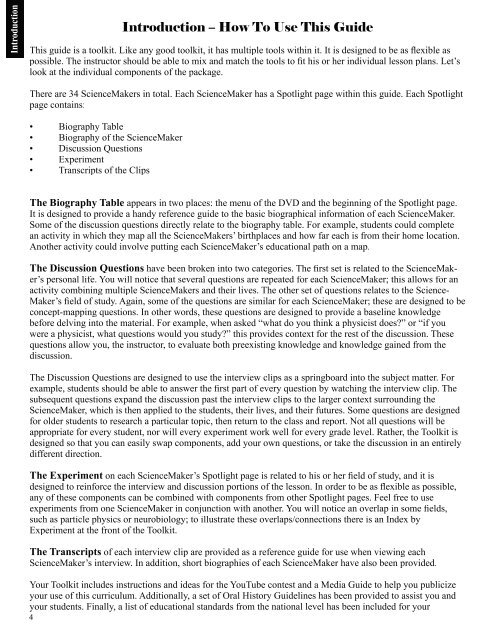ScienceMakers Toolkit Manual - The History Makers
ScienceMakers Toolkit Manual - The History Makers
ScienceMakers Toolkit Manual - The History Makers
Create successful ePaper yourself
Turn your PDF publications into a flip-book with our unique Google optimized e-Paper software.
Introduction<br />
Introduction – How To Use This Guide<br />
This guide is a toolkit. Like any good toolkit, it has multiple tools within it. It is designed to be as fl exible as<br />
possible. <strong>The</strong> instructor should be able to mix and match the tools to fi t his or her individual lesson plans. Let’s<br />
look at the individual components of the package.<br />
<strong>The</strong>re are 34 <strong>Science<strong>Makers</strong></strong> in total. Each ScienceMaker has a Spotlight page within this guide. Each Spotlight<br />
page contains:<br />
• Biography Table<br />
• Biography of the ScienceMaker<br />
• Discussion Questions<br />
• Experiment<br />
• Transcripts of the Clips<br />
<strong>The</strong> Biography Table appears in two places: the menu of the DVD and the beginning of the Spotlight page.<br />
It is designed to provide a handy reference guide to the basic biographical information of each ScienceMaker.<br />
Some of the discussion questions directly relate to the biography table. For example, students could complete<br />
an activity in which they map all the <strong>Science<strong>Makers</strong></strong>’ birthplaces and how far each is from their home location.<br />
Another activity could involve putting each ScienceMaker’s educational path on a map.<br />
<strong>The</strong> Discussion Questions have been broken into two categories. <strong>The</strong> fi rst set is related to the ScienceMaker’s<br />
personal life. You will notice that several questions are repeated for each ScienceMaker; this allows for an<br />
activity combining multiple <strong>Science<strong>Makers</strong></strong> and their lives. <strong>The</strong> other set of questions relates to the Science-<br />
Maker’s fi eld of study. Again, some of the questions are similar for each ScienceMaker; these are designed to be<br />
concept-mapping questions. In other words, these questions are designed to provide a baseline knowledge<br />
before delving into the material. For example, when asked “what do you think a physicist does?” or “if you<br />
were a physicist, what questions would you study?” this provides context for the rest of the discussion. <strong>The</strong>se<br />
questions allow you, the instructor, to evaluate both preexisting knowledge and knowledge gained from the<br />
discussion.<br />
<strong>The</strong> Discussion Questions are designed to use the interview clips as a springboard into the subject matter. For<br />
example, students should be able to answer the fi rst part of every question by watching the interview clip. <strong>The</strong><br />
subsequent questions expand the discussion past the interview clips to the larger context surrounding the<br />
ScienceMaker, which is then applied to the students, their lives, and their futures. Some questions are designed<br />
for older students to research a particular topic, then return to the class and report. Not all questions will be<br />
appropriate for every student, nor will every experiment work well for every grade level. Rather, the <strong>Toolkit</strong> is<br />
designed so that you can easily swap components, add your own questions, or take the discussion in an entirely<br />
different direction.<br />
<strong>The</strong> Experiment on each ScienceMaker’s Spotlight page is related to his or her fi eld of study, and it is<br />
designed to reinforce the interview and discussion portions of the lesson. In order to be as fl exible as possible,<br />
any of these components can be combined with components from other Spotlight pages. Feel free to use<br />
experiments from one ScienceMaker in conjunction with another. You will notice an overlap in some fi elds,<br />
such as particle physics or neurobiology; to illustrate these overlaps/connections there is an Index by<br />
Experiment at the front of the <strong>Toolkit</strong>.<br />
<strong>The</strong> Transcripts of each interview clip are provided as a reference guide for use when viewing each<br />
ScienceMaker’s interview. In addition, short biographies of each ScienceMaker have also been provided.<br />
Your <strong>Toolkit</strong> includes instructions and ideas for the YouTube contest and a Media Guide to help you publicize<br />
your use of this curriculum. Additionally, a set of Oral <strong>History</strong> Guidelines has been provided to assist you and<br />
your students. Finally, a list of educational standards from the national level has been included for your<br />
4










